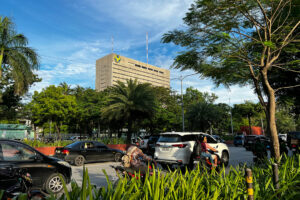
TDF yields slip on BSP, Fed bets
TERM DEPOSIT yields slipped on Wednesday as the offer went undersubscribed and with markets anticipating further policy easing by both the Bangko Sentral ng Pilipinas (BSP) and US central bank.
The BSP’s term deposit facility (TDF) attracted bids worth P250.598 billion, below the P280 billion on the auction block and P290.223 billion in bids a week ago for a P250-billion offer.
Tenders for the seven-day debt reached P154.953 billion, lower than the P160 billion auctioned off by the central bank. This was also below the P177.147 billion in bids seen for the P140 billion offered last week.
Banks asked for yields of 5.975% to 6.0815%, narrower than the 5.97% to 6.0825% margin a week earlier. This caused the average rate of the one-week deposits to slip by 0.32 basis point (bp) to 6.0584% from 6.0616% previously.
Meanwhile, bids for the 14-day term deposits reached P95.645 billion, also lower than the P120-billion offer and P113.076 billion in tenders a week ago for the P110 billion placed on the auction block.
Accepted rates ranged from 6% to 6.125%, steady from the margin seen a week ago. Still, the average rate for the two-week deposits decreased by 0.18 bp to 6.0902% from 6.092% last week.
Meanwhile, the BSP has not auctioned off 28-day term deposits for more than four years to give way to its weekly offer of securities with the same tenor.
The central bank uses the term deposits and the BSP bills to mop up excess liquidity in the financial system and to better guide market rates.
Term deposit yields declined amid expectations of further policy easing by the Philippine central bank, Michael L. Ricafort, chief economist at Rizal Commercial Banking Corp., said in a Viber message.
BSP Governor Eli M. Remolona, Jr. last week said the Monetary Board could either keep or cut benchmark rates at its Dec. 19 policy meeting.
Inflationary pressures would warrant a pause, while weaker-than-expected growth would pave the way for another rate cut, he said.
Since August, the BSP has delivered a total of 50 bps worth of cuts, bringing the policy rate to 6%.
Markets are also pricing in further reductions from the US Federal Reserve, Mr. Ricafort added.
Consumers’ average inflation expectations over the next 12 months dropped to 4.9%, the lowest since March 2020, from 5.3% in October, Reuters reported.
Nonetheless, high prices remain a concern, with consumers saying lower prices was their top wish for the new year. Frustration over inflation swept Trump to victory over Vice President and Democratic Party candidate Kamala Harris.
There are, however, concerns that the president-elect’s economic policies could stoke inflation, and slow the pace of interest rate cuts next year.
Minutes of the Federal Reserve’s Nov 6-7 policy meeting published on Tuesday showed officials appeared divided over how much farther they may need to cut rates. The US central bank started lowering rates in September, having hiked them in 2022 and 2023 to combat inflation.
Markets currently see a 63% chance of a 25-basis-point rate cut by the Fed in December, as per the CME group’s FedWatch tool.
Mr. Ricafort also cited the decline in global crude oil prices.
Oil prices steadied on Wednesday, with markets assessing the potential impact of a ceasefire deal between Israel and Hezbollah, and ahead of Sunday’s OPEC+ meeting of producers, Reuters reported.
Brent crude futures rose 5 cents to $72.86 a barrel by 0415 GMT, while US West Texas Intermediate crude futures were up 3 cents at $68.80 a barrel. — Luisa Maria Jacinta C. Jocson with Reuters
